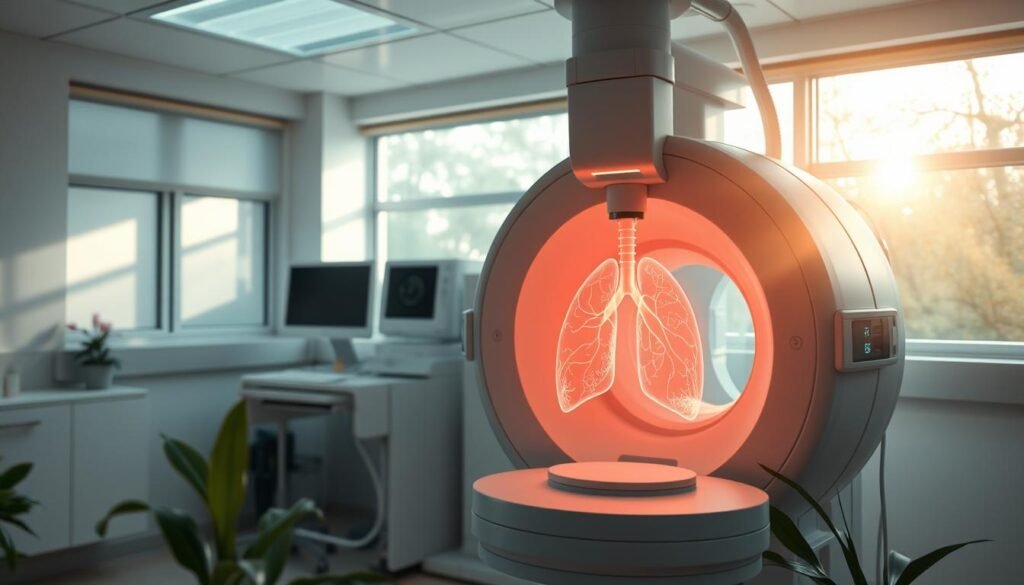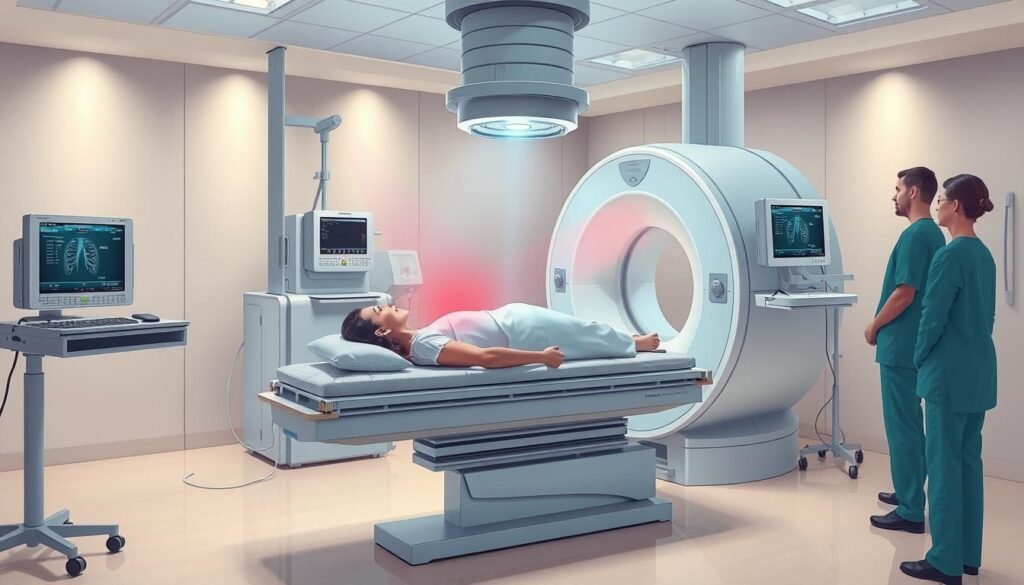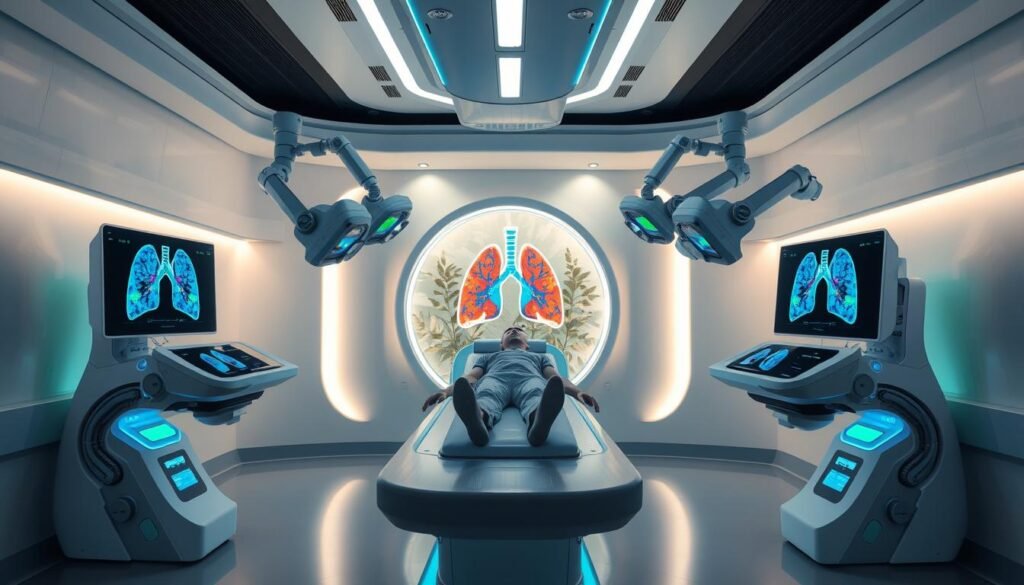Lung cancer is the top cause of cancer deaths in the United States. It’s responsible for about 25% of all cancer deaths. This shocking fact highlights the need for effective treatments like radiotherapy for lung cancer. There are many types of cancer radiotherapy. Both patients and doctors must understand them well to choose the best option.
This guide provides a detailed look at radiotherapy options. These include external beam radiation therapy (EBRT), proton therapy, and stereotactic body radiation therapy (SBRT). Knowing about these treatments can lead to better results and quality of life for those affected.
Every aspect of treatment, from start to finish, is covered to help patients and their caregivers. It ensures everyone is supported and informed throughout the journey. For further information on this important part of lung cancer treatment, check radiation therapy resources to learn more about the available options.
Key Takeaways
- Lung cancer is a major health issue, needing effective treatment methods.
- Radiotherapy, with methods like EBRT and SBRT, is crucial in fighting lung cancer.
- Learning about different treatments and advancements helps in making the right choices.
- It’s important to manage and understand potential side effects during treatment.
- Regular follow-ups are key to a good recovery and dealing with any issues.
Understanding Lung Cancer
Lung cancer is a major health issue in the United States. It’s critical to know about the different types and the high numbers involved. Also, understanding the key risk factors can help in awareness and prevention.
Types of Lung Cancer
There are mainly two kinds of lung cancer: NSCLC and SCLC. NSCLC makes up about 85% of cases. Adenocarcinoma is the most common type of NSCLC, half of the cases. Squamous cell carcinoma and large-cell carcinoma are other types of NSCLC.
SCLC is less common but grows and spreads faster.
Statistics and Prevalence
Lung cancer is the top cause of cancer deaths in the U.S. Every year, around 220,000 new cases are diagnosed. Sadly, it causes about 155,000 deaths annually. This makes it a serious threat to everyone. Sadly, only 17% are found early, leading to lower survival rates. Lung cancer makes up 14% of all new cancer cases. This shows how common and serious it is, highlighting the need for more research and better treatments.
Risk Factors Associated with Lung Cancer
Many factors increase the risk of getting lung cancer. Smoking is the biggest one, causing 85% to 90% of cases. Secondhand smoke, radon gas, and pollution are also dangerous. Genetics can also affect your risk. It’s important to know these risks to prevent the disease.
It’s crucial to understand the details of lung cancer. This includes knowing its types, statistics, and what increases the risk. For more on treating lung cancer, especially with radiation therapy, check out this link.
The Role of Radiotherapy in Lung Cancer Treatment
Radiotherapy is crucial in treating lung cancer. It works with other treatments to attack the disease. Technology has made radiotherapy more accurate. This means it targets tumors better and protects healthy tissues.
Integration with Other Treatment Modalities
Radiotherapy can be the main treatment or support other treatments like chemotherapy and surgery. It might be used before surgery to make tumors smaller. Or it can be used during or after surgery to get rid of cancer cells. Thanks to this radiation therapy integration, doctors can create treatment plans that are just right for each patient.
Benefits of Radiotherapy in Lung Cancer
Studies show radiotherapy is effective for lung cancer. SBRT, for example, has a high success rate in treating non-small cell lung cancer. It’s especially good when surgery is not an option. This shows the big radiotherapy benefits in such cases.
Modern radiotherapy is very precise. This helps doctors treat lung cancer while reducing side effects. With new improvements, radiotherapy continues to be a key part of lung cancer treatment.

Types of Radiotherapy Used in Lung Cancer
Lung cancer treatment often uses different kinds of radiotherapy. Each type is chosen to fit the patient’s needs best. Knowing the options helps doctors pick the right treatment.
External Beam Radiation Therapy (EBRT)
External beam radiation therapy is a common choice for treating lung cancer. It uses high-energy X-rays from outside the body aimed at tumors. The goal is to hit the tumor hard while keeping the healthy tissue safe. EBRT can be the main treatment or used with others like chemotherapy.
Brachytherapy and Its Application
Brachytherapy puts radioactive material right next to or inside the tumor. This direct approach hits the cancer hard in a small area. It’s great for some lung cancers because it doesn’t affect as much of the body as other treatments do.
Proton Beam Therapy Explained
Proton beam therapy is a newer treatment that uses protons instead of X-rays. It’s good for tumors close to important body parts because it limits harm to healthy organs. This accuracy is making proton beam therapy more popular.
Stereotactic Body Radiation Therapy (SBRT)
SBRT is an advanced method delivering high radiation doses accurately to tumors. It usually needs just 1 to 10 sessions. Tools like TrueBeam™ and CyberKnife® help track the tumor during treatment. This ensures that the radiation hits its target, even if the patient moves.
Intensity-Modulated Radiation Therapy (IMRT)
IMRT is a big step forward in radiation therapy. It treats tumors at varying doses, which helps save healthy tissue. RapidArc® technology in IMRT makes the treatment quicker and more precise. This means patients spend less time undergoing treatment.

| Type of Therapy | Key Features | Typical Sessions |
|---|---|---|
| External Beam Radiation Therapy (EBRT) | High-energy X-rays from outside the body, customizable doses | Varies by case |
| Brachytherapy | Radioactive materials placed near the tumor, localized treatment | Usually a few sessions |
| Proton Beam Therapy | Utilizes protons for targeted treatment, reduced risk to healthy organs | Varies by case |
| Stereotactic Body Radiation Therapy (SBRT) | High doses in fewer sessions, precise tracking technology | 1 to 10 sessions |
| Intensity-Modulated Radiation Therapy (IMRT) | Variable dosing, protects healthy tissue, faster treatment | Varies by case |
Radiotherapy for Lung Cancer: Techniques and Innovations
Radiotherapy has made big leaps forward. It has led to new methods that improve lung cancer treatment. These methods aim to focus radiation on the cancer while protecting the healthy tissue around it. We’ve seen big steps forward with the introduction of Three-Dimensional Conformal Radiation Therapy (3D-CRT), Volumetric Modulated Arc Therapy (VMAT), and Four-Dimensional Conformal Radiation Therapy (4DCT).
Three-Dimensional Conformal Radiation Therapy (3D-CRT)
3D-CRT marks a huge step in bettering radiation therapy. It uses detailed imaging to outline the tumor’s shape and spot. It precisely targets the tumor. This means it hits the cancer cells hard while keeping the healthy cells safe. This careful approach lessens side effects, placing 3D-CRT at the forefront of radiotherapy progress.
Volumetric Modulated Arc Therapy (VMAT)
VMAT makes lung cancer radiation treatment more efficient. It sends radiation from many angles in one machine rotation. This benefits patients by cutting down treatment time but keeps radiation precise. This method makes the treatment quicker and easier for patients, improving their overall experience.
Four-Dimensional Conformal Radiation Therapy (4DCT)
4DCT is key in tracking tumor movement, especially with breathing. It watches tumor shifts in real-time, making on-the-go adjustments. By keeping up with breathing changes, 4DCT targets tumors with high precision. This approach is crucial in treating lung cancer. Adding 3D-CRT, VMAT, and 4DCT to treatment options shows our commitment to bettering radiotherapy, which helps patients a lot.

Preparation and Procedure for Radiotherapy
Getting ready for radiotherapy for lung cancer is key. It makes the treatment work well. This part includes meetings and tests to learn more about your health. Knowing about these steps can make you feel ready and clear about your treatment.
Initial Consultation and Diagnostic Tests
The first step is the initial consultation. Doctors review your health history and talk about how you feel. They do diagnostic tests for lung cancer, like CT and PET scans. These scans show the tumor’s size and place. This info is very important for planning your treatment.
Simulation Process Prior to Treatment
After getting scanned, there’s a simulation. It figures out how you should lie during treatment. Imaging makes a model of where you’ll get radiation. Getting you in the right spot helps target the cancer and protect healthy tissue. It makes the therapy work best.
Designing the Treatment Plan
Then, doctors make a radiation treatment plan just for you. They use scan results to decide on radiation doses and angles. Every detail is thought out to attack the tumor effectively and safely. This plan is key to make sure your treatment works while keeping risks low.
Understanding the Treatment Process
Lung cancer radiotherapy is a step-by-step method aimed at meeting treatment goals. Patients will experience a series of careful steps that focus on safety and results. Radiotherapy sessions are short and painless, which is reassuring during a tough time.
What to Expect During Treatment
Patients will have several radiotherapy sessions, typically five times a week for a few weeks. Each session is just a few minutes long. Since radiation therapy is non-invasive, patients can get back to their normal lives quickly after each session.
Frequency and Duration of Sessions
The number of radiotherapy sessions depends on the lung cancer type and overall treatment plan. For example:
| Condition | Typical Session Frequency | Duration of Treatment |
|---|---|---|
| Early-stage NSCLC | 5 days a week | 6-8 weeks |
| Limited-stage SCLC | 5 days a week | 4-6 weeks |
| Palliative Care | Varies | Depends on patient needs |
Monitoring and Follow-Up Care
Monitoring during treatment is key to check if the therapy works and manage side effects. Doctors will set follow-up meetings to see how the patient is reacting to the treatment and adjust if needed. This proactive approach helps ensure the best recovery and improves the treatment journey.
Side Effects of Radiotherapy for Lung Cancer
Radiotherapy is key in treating lung cancer. But, it brings side effects during and after treatment. It’s vital to know about these effects and how to handle them. Talking to healthcare providers helps manage symptoms well.
Common Side Effects of Radiation
Radiotherapy can cause some short-term side effects. They vary in how strong they are. Key side effects include:
- Difficulty Swallowing: Patients like David and Laurel had trouble swallowing. They needed to change their diet and use high-calorie drinks to avoid losing weight.
- Feeling or Being Sick: Laurel and David felt sick a lot. Doctors gave them medicine for this. They also recommended staying away from fatty foods.
- Shortness of Breath: After treatment, David found it hard to breathe. He needed inhalers and advice from doctors for this problem.
Management of Side Effects
Handling radiotherapy side effects means changing your lifestyle and getting medical help. Here’s what patients can do:
- Try different foods to make swallowing easier.
- Stay away from foods that can hurt your throat.
- Drink lots of water to stay hydrated.
- Consult a dietitian to get help with what you eat.
- Get treatment for any ongoing issues.
Being active in managing side effects can make treatment easier. Working with healthcare teams lets patients find the best ways to tackle their unique challenges.
| Side Effect | Possible Recommendations |
|---|---|
| Difficulty Swallowing | Try soft foods, high-calorie drinks |
| Feeling or Being Sick | Take anti-sickness medication, avoid fatty foods |
| Shortness of Breath | Use inhalers, seek fast medical advice |
Palliative Radiotherapy for Advanced Lung Cancer
Palliative radiotherapy is crucial in treating advanced lung cancer. It focuses on improving the patient’s quality of life as the illness gets worse. For those with non-small-cell lung cancer (NSCLC), which is 85% of cases, it’s especially important.
Indications for Palliative Radiotherapy
This type of treatment is for patients with severe symptoms like pain, problems swallowing, or lots of shortness of breath. About 25% of these treatments aim to ease lung cancer symptoms in the chest. The main goal is to make patients more comfortable when healing isn’t an option.
Symptom Relief Strategies
One in three patients finds that their life quality gets better with palliative EBRT. The treatment plans are flexible, fitting the patient’s needs for symptom control and what they can handle. Higher doses, like 30 Gy in ten sessions, often mean better survival and less pain.
Shorter treatments, like 20 Gy in five sessions or a single 10 Gy dose, also help a lot with fewer side effects. Combining palliative radiotherapy with other treatments can improve symptom management for those with advanced lung cancer.
Research shows radiotherapy helps with symptoms in two-thirds of lung cancer cases. A treatment plan that includes it is key for managing advanced lung cancer. It ensures patients stay as comfortable as possible. For more details, check out this informative resource.
Conclusion
Radiotherapy plays a crucial role in treating lung cancer. It offers hope and options to patients. Advanced techniques, like stereotactic body radiation therapy (SBRT), show great results. For example, SBRT has 1-year and 3-year survival rates of 94.7% and 84.7%, respectively.
Understanding each treatment and preparing for them is key for lung cancer patients. A team approach covers all needs from the first visit to follow-up care. With modern technology and personalized plans, patients can expect better support and results.
Staying informed about lung cancer radiotherapy and working with doctors is vital. It helps patients make smart choices about their care. This approach helps them face lung cancer with hope and confidence in the recovery process.